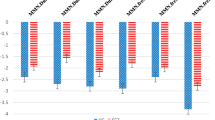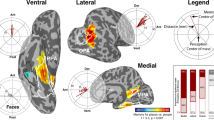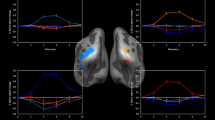Abstract
Although the importance of the posterior parietal and prefrontal regions in spatial localization of visual stimuli is well established, their role in auditory space perception is less clear. Using positron emission tomography (PET) during auditory and visual spatial localization in the same subjects, modality-specific areas were identified in the superior parietal lobule, middle temporal and lateral prefrontal cortices. These findings suggest that, similar to the visual system, the hierarchical organization of the auditory system extends beyond the temporal lobe to include areas in the posterior parietal and prefrontal regions specialized in auditory spatial processing. Our results may explain the dissociation of visual and auditory spatial localization deficits following lesions involving these regions.
This is a preview of subscription content, access via your institution
Access options
Subscribe to this journal
Receive 12 print issues and online access
$209.00 per year
only $17.42 per issue
Buy this article
- Purchase on Springer Link
- Instant access to full article PDF
Prices may be subject to local taxes which are calculated during checkout


Similar content being viewed by others
References
Blauert, J. Spatial Hearing: The Psychophysics of Human Sound Localisation (MIT press, Cambridge, 1983).
King, A. J. & Palmer, A. R. Cells responsive to free-field auditory stimuli in guinea-pig superior colliculus: distribution and response properties. J. Physiol. (Lond.) 342, 361 –381 (1983).
Knudsen, E. I. & Konishi, M. A neural map of auditory space in the owl. Science 200, 795– 797 (1978).
Rauschecker, J. P. Cortical processing of complex sounds. Curr. Opin. Neurobiol. 8, 516–521 (1998).
Cranford, J., Ravizza, R., Diamond, I. T. & Whitfield, I. C. Unilateral ablation of the auditory cortex in the cat impairs complex sound localization. Science 172, 286– 288 (1971).
Heffner, H. & Masterton, B. Contribution of auditory cortex to sound localization in the monkey (Macaca mulatta). J. Neurophysiol. 38, 1340–1358 (1975).
Jenkins, W. M. & Merzenich, M. M. Role of cat primary auditory cortex for sound-localization behavior. J. Neurophysiol. 52, 819–847 (1984).
Wegener, J. The sound locating behaviour of brain damaged monkeys. J. Aud. Res. 13, 191–219 ( 1973).
Middlebrooks, J. C., Clock, A. E., Xu, L. & Green, D. M. A panoramic code for sound location by cortical neurons. Science 264 , 842–844 (1994).
Stricanne, B., Andersen, R. A. & Mazzoni, P. Eye-centered, head-centered, and intermediate coding of remembered sound locations in area LIP. J. Neurophysiol. 76, 2071–2076 (1996).
Vaadia, E. Single-unit activity related to active localization of acoustic and visual stimuli in the frontal cortex of the rhesus monkey. Brain Behav. Evol. 33, 127–131 ( 1989).
Mazzoni, P., Bracewell, R. M., Barash, S. & Andersen, R. A. Spatially tuned auditory responses in area LIP of macaques performing delayed memory saccades to acoustic targets. J. Neurophysiol. 75, 1233–1241 (1996).
Azuma, M. & Suzuki, H. Properties and distribution of auditory neurons in the dorsolateral prefrontal cortex of the alert monkey. Brain Res. 298, 343–346 (1984).
Sanchez-Longo, L. P. & Forster, F. M. Clinical significance of sound localization. Neurology 8, 119– 125 (1958).
Jerger, J., Lovering, L. & Wertz, M. Auditory disorder following bilateral temporal lobe insult: report of a case. J. Speech Hear. Disord. 37 , 523–535 (1972).
Bender, M. & Diamond, S. An analysis of auditory perceptual defects with observations on the localization of dysfunction. Brain 88, 675–686 ( 1965).
Heilman, K. M., Pandya, D. N., Karol, E. A. & Geschwind, N. Auditory inattention. Arch. Neurol. 24, 323–325 (1971).
De Renzi, E., Gentilini, M. & Pattacini, F. Auditory extinction following hemisphere damage. Neuropsychologia 22, 733–744 (1984).
De Renzi, E., Gentilini, M. & Barbieri, C. Auditory neglect. J. Neurol. Neurosurg. Psychiatry 52, 613–617 ( 1989).
Weeks, R. et al. A PET study of auditory spatial processing. Neurosci. Lett. (in press).
Griffiths, T. et al. Right parietal cortex is involved in the perception of sound movement in humans. Nat. Neurosci. 1, 74 –79 (1998).
Corbetta, M., Miezin, F. M., Shulman, G. L. & Petersen, S. E. A PET study of visuospatial attention. J. Neurosci. 13, 1202–1226 (1993).
Haxby, J. V. et al. The functional organization of human extrastriate cortex: a PET-rCBF study of selective attention to faces and locations. J. Neurosci. 14, 6336–6353 (1994).
Nobre, A. C. et al. Functional localization of the system for visuospatial attention using positron emission tomography. Brain 120, 515–533 (1997).
Andersen, R. A., Snyder, L. H., Bradley, D. C. & Xing, J. Multimodal representation of space in the posterior parietal cortex and its use in planning movements. Annu. Rev. Neurosci. 20, 303–330 (1997).
Wightman, F. L. & Kistler, D. J. Headphone simulation of free-field listening. I: Stimulus synthesis. II: Psychophysical validation. J. Acoust. Soc. Am. 85, 858– 878 (1989).
Wenzel, E. M., Arruda, M., Kistler, D. J. & Wightman, F. L. Localization using nonindividualized head-related transfer functions. J. Acoust. Soc. Am. 94, 111–123 (1993).
Brugge, J. F., Reale, R. A. & Hind, J. E. The structure of spatial receptive fields of neurons in primary auditory cortex of the cat. J. Neurosci. 16, 4420–4437 (1996).
Sweeney, J. A. et al. Positron emission tomography study of voluntary saccadic eye movements and spatial working memory. J. Neurophysiol. 75, 454–468 (1996).
Milner, A. Neglect, Extinction, and the Cortical Streams of Visual Processing (Springer, Heidelberg, 1997).
Young, A. W., Hellawell, D. J. & Welch, J. Neglect and visual recognition. Brain 115, 51–71 (1992).
Harrington, D. L., Haaland, K. Y. & Knight, R. T. Cortical networks underlying mechanisms of time perception. J. Neurosci. 18, 1085– 1095 (1998).
Pardo, J. V., Fox, P. T. & Raichle, M. E. Localization of a human system for sustained attention by positron emission tomography. Nature 349, 61–64 (1991).
Maquet, P. et al. Brain activation induced by estimation of duration: a PET study. Neuroimage 3, 119– 126 (1996).
Watson, R. T., Valenstein, E., Day, A. & Heilman, K. M. Posterior neocortical systems subserving awareness and neglect. Neglect associated with superior temporal sulcus but not area 7 lesions. Arch. Neurol. 51, 1014–1021 (1994).
Fink, G. R., Dolan, R. J., Halligan, P. W., Marshall, J. C. & Frith, C. D. Space-based and object-based visual attention: shared and specific neural domains. Brain 18, 2013–2028 (1997).
McCarthy, G. et al. Functional magnetic resonance imaging of human prefrontal cortex activation during a spatial working memory task. Proc. Natl. Acad. Sci. USA 91, 8690–8694 (1994).
Courtney, S. M., Petit, L., Maisog, J. M., Ungerleider, L. G. & Haxby, J. V. An area specialized for spatial working memory in human frontal cortex. Science 279, 1347– 1351 (1998).
Russo, G. S. & Bruce, C. J. Frontal eye field activity preceding aurally guided saccades. J. Neurophysiol. 71, 1250–1253 (1994).
Ungerleider, L. G., Courtney, S. M. & Haxby, J. V. A neural system for human visual working memory. Proc. Natl. Acad. Sci. USA 95, 883– 890 (1998).
Zatorre, R. J., Perry, D. W., Beckett, C. A., Westbury, C. F. & Evans, A. C. Functional anatomy of musical processing in listeners with absolute pitch and relative pitch. Proc. Natl. Acad. Sci. USA 95, 3172–3177 (1998).
Ahissar, M., Ahissar, E., Bergman, H. & Vaadia, E. Encoding of sound-source location and movement: activity of single neurons and interactions between adjacent neurons in the monkey auditory cortex. J. Neurophysiol. 67, 203–215 ( 1992).
Ward, L. M. Supramodal and modality-specific mechanisms for stimulus-driven shifts of auditory and visual attention. Can. J. Exp. Psychol. 48, 242–259 (1994).
Farah, M. J., Wong, A. B., Monheit, M .A. & Morrow, L. A. Parietal lobe mechanisms of spatial attention: modality-specific or supramodal? Neuropsychologia 27, 461– 470 (1989).
Soroker, N., Calamaro, N., Glicksohn, J. & Myslobodsky, M. S. Auditory inattention in right-hemisphere-damaged patients with and without visual neglect. Neuropsychologia 35, 249 –256 (1997).
Herscovitch, P., Markham, J. & Raichle, M. E. Brain blood flow measured with intravenous H2(15)O. I. Theory and error analysis. J. Nucl. Med. 24, 782–789 (1983).
Woods, R. P., Cherry, S. R. & Mazziotta, J. C. Rapid automated algorithm for aligning and reslicing PET images. J. Comput. Assist. Tomogr. 16, 620–633 (1992).
Lacquaniti, F. et al. Visuomotor transformations for reaching to memorized targets: a PET study. Neuroimage 5, 129– 146 (1997).
Friston, K.J. Testing for anatomically specified regional effects. Hum. Brain Mapp. 5, 133–136 ( 1997).
Price, C. J. & Friston, K. J. Cognitive conjunction: a new approach to brain activation experiments. Neuroimage 5, 261–270 (1997).
Acknowledgements
We thank Devera G. Schoenberg for editing the manuscript and Nguyet Dang and George Dold for their assistance with computer programming.
Author information
Authors and Affiliations
Corresponding author
Rights and permissions
About this article
Cite this article
Bushara, K., Weeks, R., Ishii, K. et al. Modality-specific frontal and parietal areas for auditory and visual spatial localization in humans. Nat Neurosci 2, 759–766 (1999). https://doi.org/10.1038/11239
Received:
Accepted:
Issue Date:
DOI: https://doi.org/10.1038/11239
This article is cited by
-
A new map of the rat isocortex and proisocortex: cytoarchitecture and M2 receptor distribution patterns
Brain Structure and Function (2023)
-
Voxel-based meta-analysis of gray matter abnormalities in idiopathic dystonia
Journal of Neurology (2022)
-
Cortical mechanisms of spatial hearing
Nature Reviews Neuroscience (2019)
-
Cortical Processing of Level Cues for Spatial Hearing is Impaired in Children with Prelingual Deafness Despite Early Bilateral Access to Sound
Brain Topography (2018)
-
Supramodal effect of rightward prismatic adaptation on spatial representations within the ventral attentional system
Brain Structure and Function (2017)



